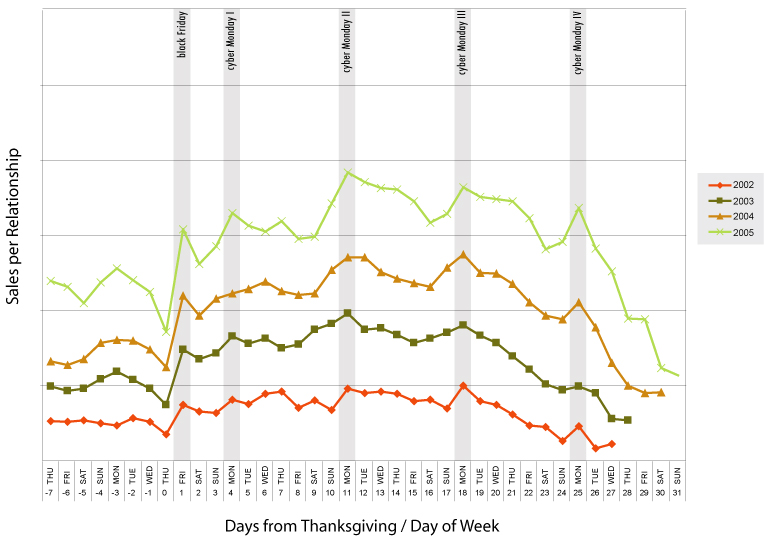(Chief Marketer) With each passing season, search helps marketers accomplish an increasing array of goals. This year is no exception; search continues to gain share from other marketing channels and register impressive growth rates when nurtured with proactive budgeting and strategy. In fact, while the National Retail Federation is projecting a 5% year-over-year increase in U.S. retail holiday sales, we at Performics project 50% growth in online sales from aggressively managed search programs.
To ensure that your business maximizes search’s potential this holiday season, you should remember four last-minute planning considerations:
1) Gut-check budgets for maximum growth. Traditionally marketers have struggled to forecast search budgets for the holiday season. Month-to-month growth in consumer search usage, marketers’ increasingly sophisticated use of search, and other factors lead to larger budgets, increased competition, and forecasting difficulty.
Several years of Performics 50 Search Trend Report data provide a handy rule of thumb for forecasting both sales and media spend in search:
Q4 = Q1 + Q2
If your budget falls below this benchmark, you risk leaving significant sales on the table during the peak season. The most successful search programs use aggressive strategies and expand their budgets to reflect search’s growth.
Search drives in-store transactions. In my previous column for CHIEF MARKETER, “Quantifying Online Search’s Impact on Offline Demand,” I presented the offline multiplier. This ratio helps marketers account for more than directly tracked online sales from search by quantifying search’s offline impact.
A March study by comScore, “The Role of Search In Consumer Buying,” looked at this offline component during the 2005 holiday gift season. During that period, 63% of search conversions occurred offline. Pure plays with no offline sales channel should understand this disadvantage and concentrate on other ways to drive immediate conversion and build awareness among searchers.
The study also reports that a mere 17% of search’s full value is realized through a direct search referral. Especially during the holidays, marketers must not mistake search advertising as a direct response marketing tool exclusively.
3) Search activity follows a seasonal arc, defined by phases. Don’t be distracted by the buzz about Black Friday and Cyber Monday. The Monday following Thanksgiving is not even in the top 10 days for search sales. From a search planning perspective, all phases of the seasonal arc, starting before Thanksgiving and tapering off in January, demand full attention.
In the pre-Thanksgiving stage, Google and comScore found that 60% of all searchers initiate their product category research before Nov. 15. Marketers should get out there early with broad category keywords to generate brand awareness and seed ongoing consideration.
Following Thanksgiving, each of the four Cyber Monday peak search days signals a new seasonal phase (see Figure 1 below, detailing year-over-year search activity among Performics clients). You should implement discrete strategies for each phase to reach searchers throughout the process, from early awareness to last-minute purchase of delivered items and last-second electronic gift certificate offers.
4) Search is nimble, but the more history the better. In recent years, some marketers have used search very effectively to capitalize on otherwise unspent resources. Search keywords, copy, and bid prices can be adjusted in real time, making search a nimble channel, capable of absorbing unspent or underperforming budgets from other channels even late in the season. Knowledgeable search professionals can use these resources to yield significant return.
Think about the season’s hit products. As product PR and media exposure increase, more people search, and conversion rates improve. You can maximize sales of trendy items by ensuring that your search teams act on timely opportunities quickly. Search can also help you liquidate overstocked goods before or after Christmas.
Bear in mind, however, that despite its nimbleness, a search campaign is composed of thousands of keywords, each with its own history. All the major search engines factor in that history when calculating a keyword’s rank and cost per click, with higher-performing keyword ads ranking better and costing less than competitive ads. So don’t hold back on keywords that you expect will play a role later in the season: Build their performance history early with strong positioning and ads that consider searchers’ needs and seasonal phases.
Keep these four considerations in mind to maximize search’s contribution to your holiday success.
Cam Balzer is vice president at Performics, the Chicago-based performance marketing division of DoubleClick, and a monthly contributor to CHIEF MARKETER. Contact him at [email protected].
